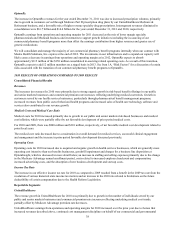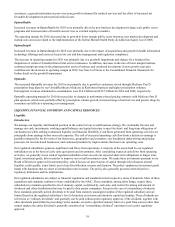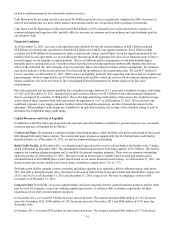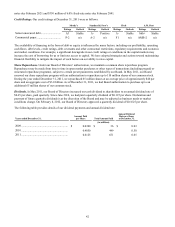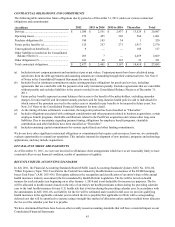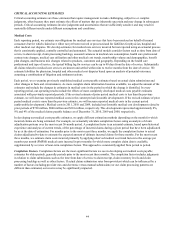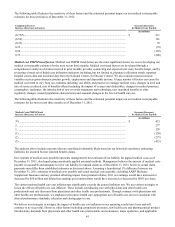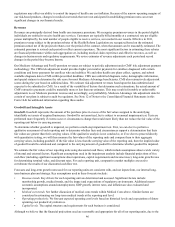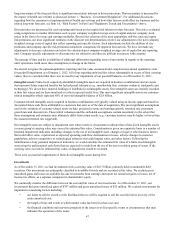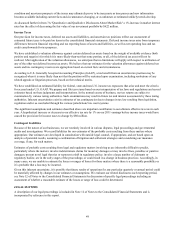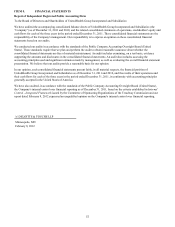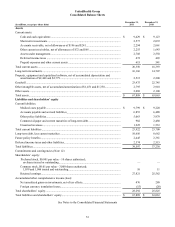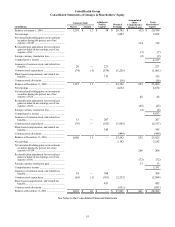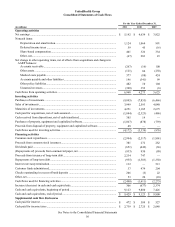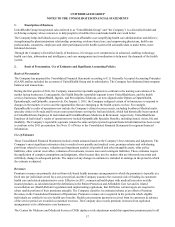United Healthcare 2011 Annual Report Download - page 49
Download and view the complete annual report
Please find page 49 of the 2011 United Healthcare annual report below. You can navigate through the pages in the report by either clicking on the pages listed below, or by using the keyword search tool below to find specific information within the annual report.47
long-term nature of the forecasts there is significant uncertainty inherent in those projections. That uncertainty is increased by
the impact of health care reforms as discussed in Item 1, “Business - Government Regulation”. For additional discussions
regarding how the enactment or implementation of health care reforms and how other factors could affect our business and the
related long-term forecasts, see Item 1A, “Risk Factors” in Part I and "Regulatory Trends and Uncertainties" above.
Discount rates are determined for each reporting unit based on the implied risk inherent in their forecasts. This risk is evaluated
using comparisons to market information such as peer company weighted average costs of capital and peer company stock
prices in the form of revenue and earnings multiples. Beyond our selection of the most appropriate risk-free rates and equity
risk premiums, our most significant estimates in the discount rate determinations involve our adjustments to the peer company
weighted average costs of capital that reflect reporting unit-specific factors. Such adjustments include the addition of size
premiums and company-specific risk premiums intended to compensate for apparent forecast risk. We have not made any
adjustments to decrease a discount rate below the calculated peer company weighted average cost of capital for any reporting
unit. Company-specific adjustments to discount rates are subjective and thus are difficult to measure with certainty.
The passage of time and the availability of additional information regarding areas of uncertainty in regards to the reporting
units' operations could cause these assumptions to change in the future.
We elected to bypass the optional qualitative reporting unit fair value assessment and completed our annual quantitative tests
for goodwill impairment as of January 1, 2012. All of our reporting units had fair values substantially in excess of their carrying
values, thus we concluded that there was no need for any impairment of our goodwill balances as of December 31, 2011.
Intangible assets. Finite-lived, separately-identifiable intangible assets are acquired in business combinations and are assets
that represent future expected benefits but lack physical substance (e.g., membership lists, customer contracts, trademarks and
technology). We do not have material holdings of indefinite-lived intangible assets. Our intangible assets are initially recorded
at their fair values and are then amortized over their expected useful lives. Our most significant intangible assets are customer-
related intangibles which represent 88% of our total intangible balance of $2.8 billion.
Customer-related intangible assets acquired in business combinations are typically valued using an income approach based on
discounted future cash flows attributable to customers that exist as of the date of acquisition. The most significant assumptions
used in the valuation of customer-related assets include: projected revenue and earnings growth, retention rate, perpetuity
growth rate and discount rate. These initial valuations and the embedded assumptions contain uncertainty to the extent that
those assumptions and estimates may ultimately differ from actual results (e.g., customer turnover may be higher or lower than
the assumed retention rate suggested).
Our intangible assets are subject to impairment tests when events or circumstances indicate that a finite-lived intangible asset's
(or asset group's) carrying value may exceed its estimated fair value. Consideration is given on a quarterly basis to a number of
potential impairment indicators including: changes in the use of an intangible asset, changes in legal or other business factors
that could affect value, experienced or expected operating cash-flow deterioration or losses, adverse changes in customer
populations, adverse competitive or technological advances that could impact value, and other factors. Following the
identification of any potential impairment indicators, we would calculate the estimated fair value of a finite-lived intangible
asset using the undiscounted cash flows that are expected to result from the use of the asset or related group of assets. If the
carrying value exceeds its estimated fair value, an impairment would be recorded.
There were no material impairments of finite-lived intangible assets during 2011.
Investments
As of December 31, 2011, we had investments with a carrying value of $18.7 billion, primarily held in marketable debt
securities. Our investments are principally classified as available-for-sale and are recorded at fair value. We exclude gross
unrealized gains and losses on available-for-sale investments from earnings and report net unrealized gains or losses, net of
income tax effects, as a separate component in shareholders' equity.
We continually monitor the difference between the cost and fair value of our investments. As of December 31, 2011, our
investments had gross unrealized gains of $787 million and gross unrealized losses of $32 million. We evaluate investments for
impairment considering factors including:
• our intent to sell the security or the likelihood that we will be required to sell the security before recovery of the
entire amortized cost;
• the length of time and extent to which market value has been less than cost; and
• the financial condition and near-term prospects of the issuer as well as specific events or circumstances that may
influence the operations of the issuer.



